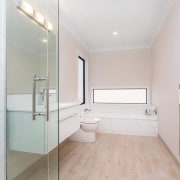How to design a house that’s affordable as well as sustainable
Daniel Casas, owner of Casas Design, offers a professional perspective on designing a house that’s kind to the planet, your energy bills and your build price.
From Daniel Casas, Casas Design Architecture Studio:
If you've decided your new home should be designed along sustainable lines – be it for the savings on power or just a love of the future of our planet generally – you'll quickly discover that many of the high-tech green designs and whizz-bang green features also come with hefty price tags.
Luckily, there is another way.
That is taking a classic or modern design and up-spec it to be super-efficient in terms of energy use and energy containment.
This means ensuring that the home is well insulated from underneath, within the walls and also in the roofing – along with double-glazing to avoid your heating efforts all going out the window. In fact, the importance of high-spec insulation underneath, around and on top can’t be overstated.

And while the actual style of home isn’t so important, one excellent starting point is having a base in concrete. This will act as a heat sump – soaking up heat from the sun during the day, only to deliver it back to the cooler rooms at night. Plus, a concrete floor is ideal for laying Hydronic radiant floor heating.
In terms of heating efficiency, anything that heats the house from the floor up has to be a plus. And it’s even more appealing when you consider solar energy derived from solar panelling is easily converted into water heating – both for your taps and for use in Hydronic pipework under your floors.
Of course, attendant to that, discreetly placed solar panelling is another must.
However, it pays to choose a solar energy option that can work together with your mains supply – after all, heating is more important in winter when there is often a lot less sun around.
There also plenty of options for low-flow taps and similar water-conservation plumbing options.

The orientation of the home and the number of windows or balconies facing to the north are also naturally all-important key factors – but these are elements that should be factored in whether the home is built for sustainability or not.
Not only do intelligently placed windows – especially north-facing windows – let more sun in to warm the concrete slab, they also provide a powerful cooling ally in the form of cross ventilation. Not much is cheaper than opening a window at one end of the room and then another at the other end.
Another design element to consider is a porch or conservatory. A well-sited conservatory can act as the lung of the building – trapping warm air by day to be released into the house proper in the evening.
While choice of cladding isn’t a deal breaker, some options are better than others. It is easy to get great looks and character from a board and baton exterior and this is a hassle-free option to insulate behind.

Rainwater harvesting is another affordable green factor, with having a steeply gabled roof to conceal the tank or burying it under ground two ways to keep what can be an unsightly element, out of sight.
On the last home we designed the owner also wanted planting beds designed as part of the landscaping – encouraging you to grow your own vegetables and herbs. Another green move is to choose plants that don’t require a tank’s worth of water to keep them looking healthy.
These are some basic ways you can look at taking a regular house design and adding valuable green credentials without breaking the bank.
Closely addressing all these elements – which are basic architectural points, really – can result in a beautiful, sustainable residence without the need for a budget-breaking, green-above-all-else design.
Story by: Daniel Casas
Photography by: Daniel Casas
Home kitchen bathroom commercial design
Classic looks, contemporary efficiency
Personality plus
Diving into nature






